現(xiàn)代醫(yī)療辦公室,美國 / Jeanne Schultz Design Studio
具有世紀中期氛圍的現(xiàn)代空間
設計公司:Jeanne Schultz Design Studio
位置:美國
類型:建筑
材料:飾面板 水磨石 鋁 木材 金屬 不銹鋼 銅 玻璃 磨砂玻璃 地毯 家具 裝飾 廚房 廚房家具/臺面 廚房設備
標簽:Austin Interior Deisgn Texas 奧斯汀 室內設計 得克薩斯州
分類:辦公室 辦公建筑 醫(yī)療建筑 診所
這座歷史性建筑是由美國奧斯丁第一位執(zhí)業(yè)婦科醫(yī)生于20世紀50年代建造的,這位醫(yī)生是社區(qū)的領袖,為高危婦女提供醫(yī)治。在之后的幾十年里,這棟建筑一直被用作普通商業(yè)辦公室。建筑于90年代末加建了第二層,由現(xiàn)在已經(jīng)解散的奧斯丁事務所QMET設計。現(xiàn)有任務是通過一系列細致入微的建筑設計策略,恢復建筑原有醫(yī)療辦公室的用途。業(yè)主是一位年輕有為的整形外科醫(yī)生,專門為變性客戶進行面部女性化服務和外科手術。
▼底層空間概覽,view of the lower floor
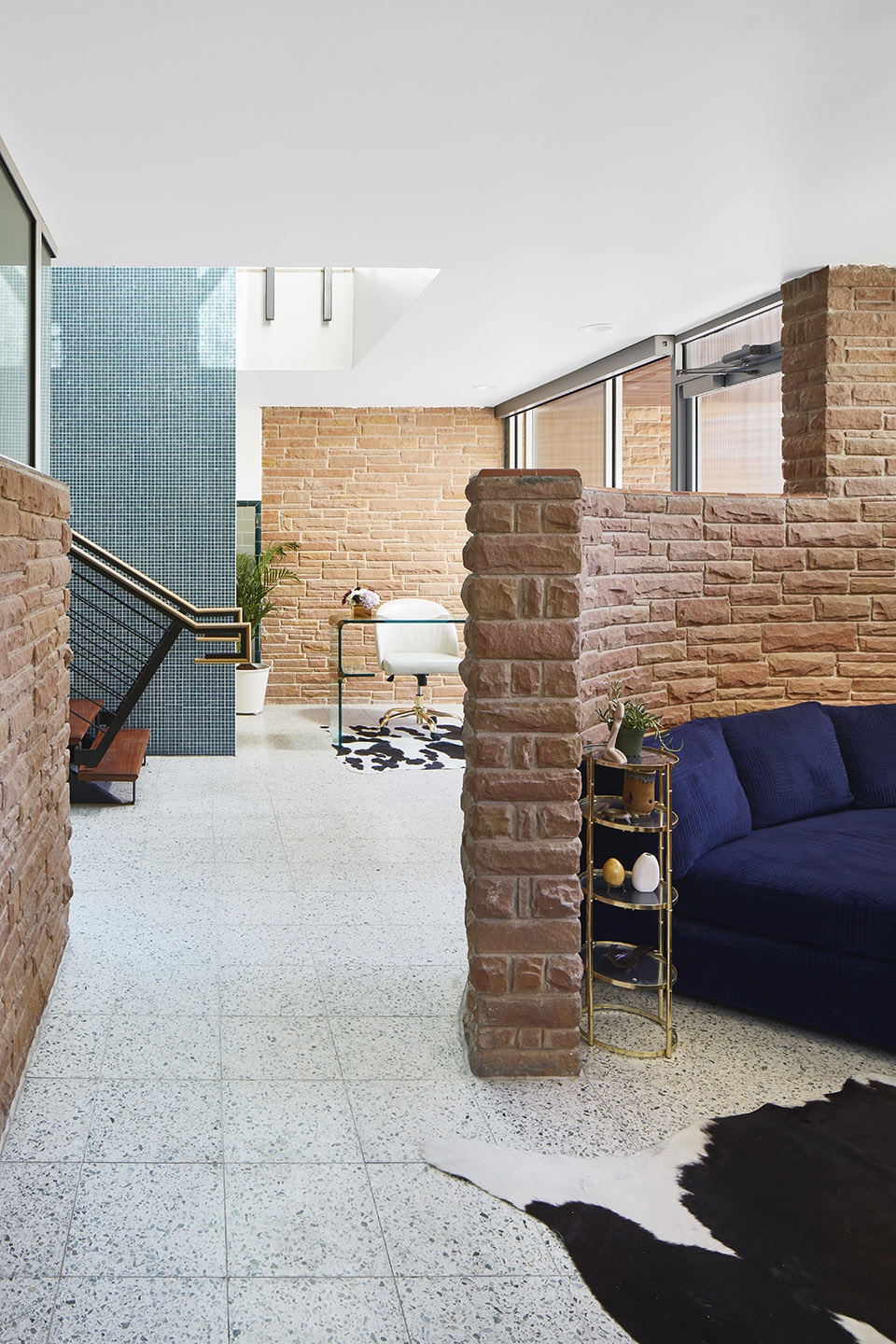
This historical building constructed in the 1950s was built by the first practicing gynecologist of Austin who was known to be a community leader and provided services to at risk women. Over the decades it was used as a general business office, then in the late ‘90s a second story addition was designed by the dissolved Austin firm QMET. The project scope included a restoration of the interior of the building to its original use as a medical office through a series of sensitive architectural and design solutions for our client, a young up-and-coming plastic surgeon who specializes in facial feminization and surgeries for transgender clients.
▼底層空間概覽,view of the lower floor
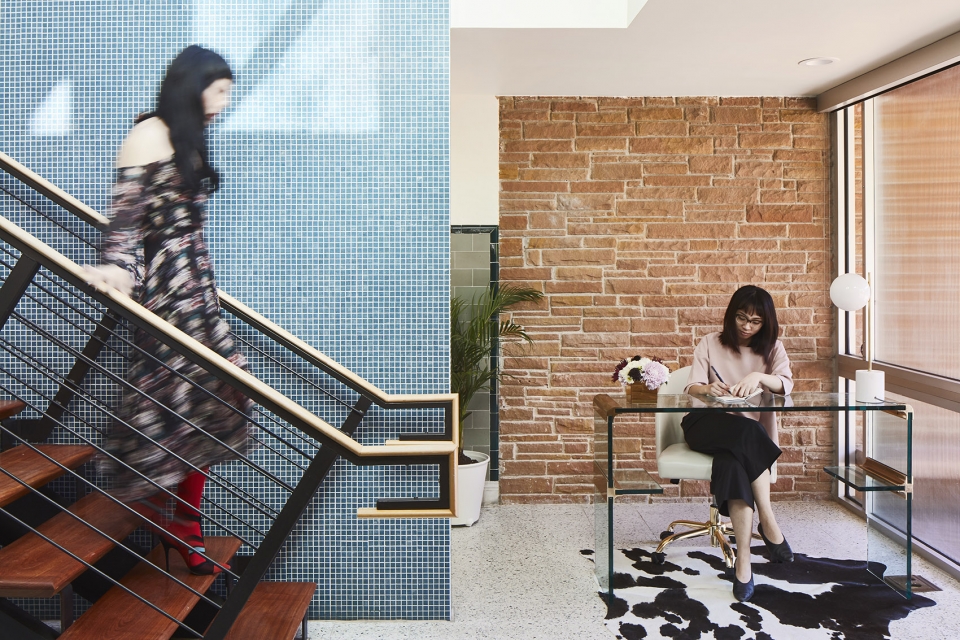
底層空間被規(guī)劃為病人主要的活動空間,現(xiàn)有室內缺乏隔斷,因此設計師需要針對可見性和隱私性進行設計。現(xiàn)存開放式平面內有兩個陶土磚半墻圍成的小隔間和一個位于后方角落里鋁板圍合的私人房間。1998年加建工程中設計建造的鋼和玻璃隔斷、原有的圓形鋼柱僅作為獨立的結構部件,與空間內的其它部分沒有任何聯(lián)系。
The lower level, where most of the patient activity was planned to occur, lacked spatial definition and demanded programming of visibility and privacy. The existing open floor plan contained two niches defined by clay-cladded half-walls and a single private room enclosed in the back corner with aluminum storefront. A steel and glass partition designed and built during the 1998 addition, as well as rounded steel columns original to the structure, stood singularly without a physical relationship to other components other than their structural connection.
▼空間內部的樓梯,interior stairs

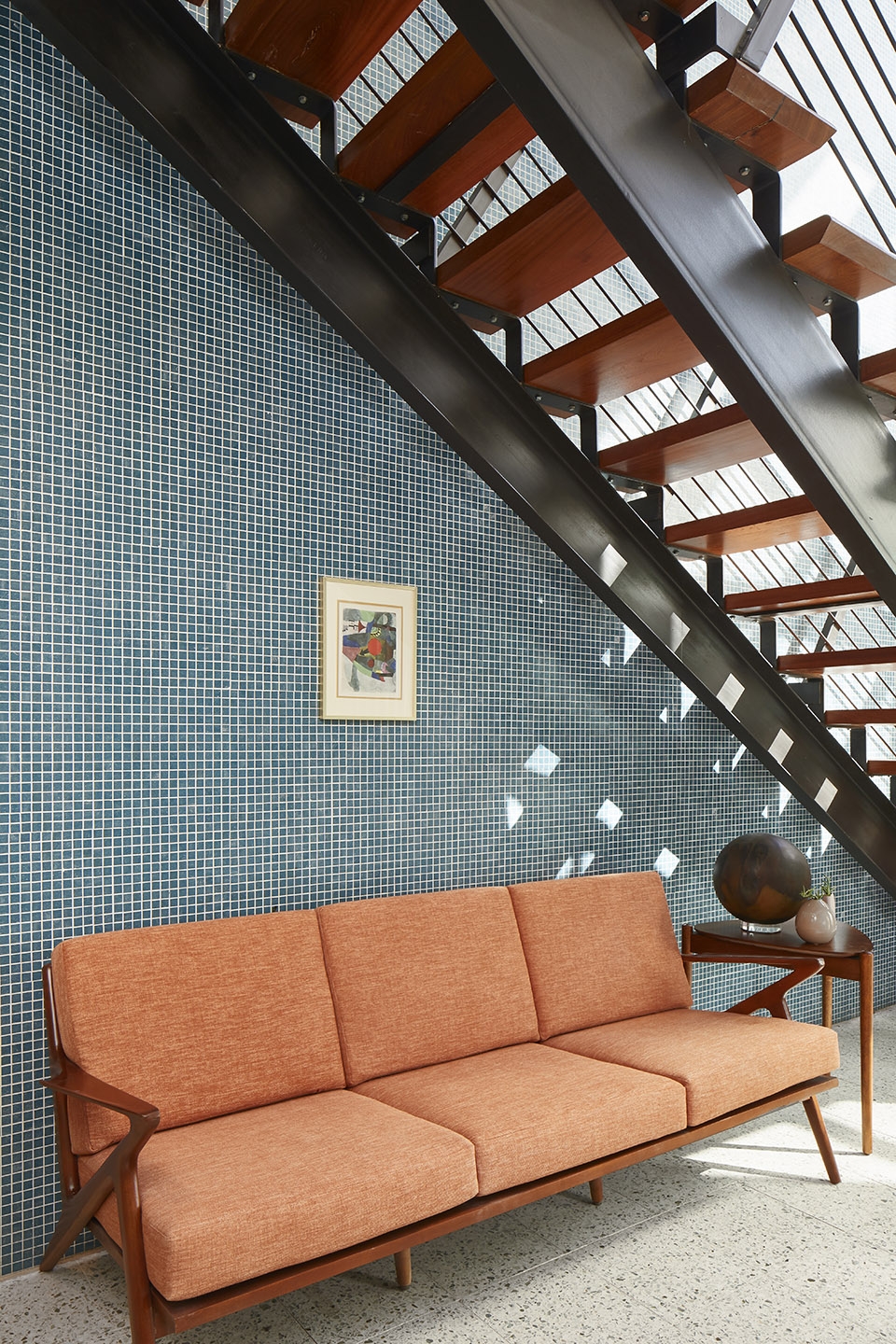
設計師利用空間中原有的鋼柱和以前的“浮動隔斷”作為空間分隔,在底層建造了兩個新的空間,借助現(xiàn)代設施維護了建筑世紀中期的特征。陶土磚半墻與后方位于底層橫向軸線上的“浮動隔斷”連接,圍合出第一間新病房。為了保證現(xiàn)存半墻的私密性,設計師增加了一個磨砂玻璃的鋁框窗戶,粘結在頂部的瓷磚上。設計師只在空間原有的灰縫和天花板上鉆孔來固定鋁制窗框,保證陶土磚不會被破壞。鋁框磨砂玻璃幕采用膠粘,以保護原有的水磨石地板,并通過天花板上的鋼結構進行加固。幕墻在幾何上被分隔成面板相同的寬度,呼應了1988年“浮動隔斷”構造。
▼陶土磚墻、磨砂玻璃、鋁制框架圍合成的病房,patient room constructed by clay wall, frosted film glass and aluminum frame
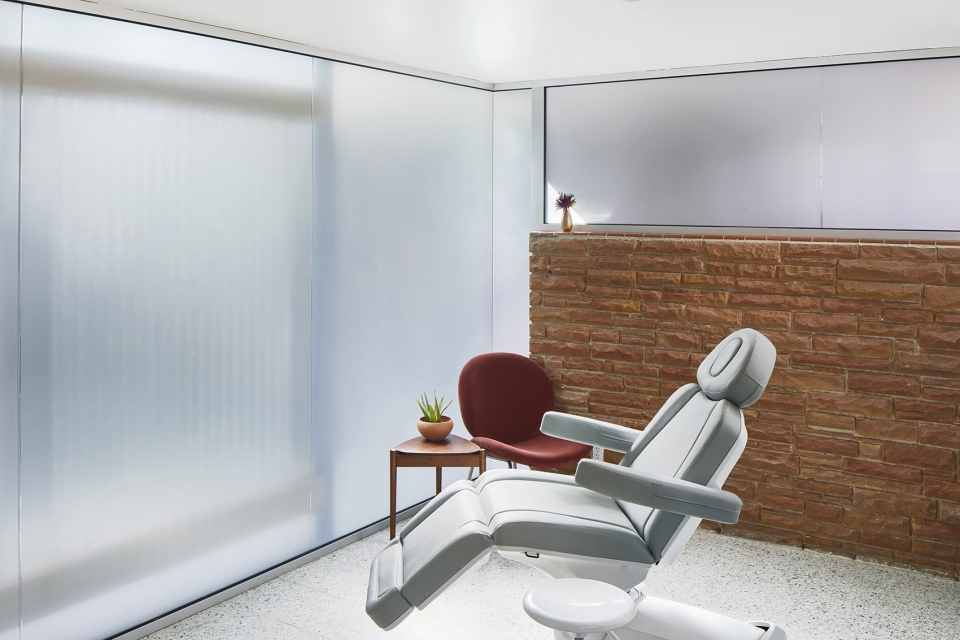
Utilizing one of the original steel columns and the once “floating partition” as a spatial demarcation, we created two new spaces on the lower level that softly complimented the midcentury character of the building with modern applications. The first new Patient Room was defined by connecting the clay half-wall that transversely divided the lower level to the axis behind the “floating partition.” To make the existing half-wall completely private, we added a butt-joint glass clerestory with frosted film which was set inside aluminum channels and then glued to the tile-capped top. We drilled into existing mortar joints only and the ceiling to anchor the aluminum channels, so the clay bricks would not be disturbed. A butt-joint glass curtain wall with frosted film set in aluminum channels was glued to protect the original terrazzo flooring, and reinforced in the steel structure of the ceiling. The geometry of the curtain wall was broken down into panel widths which reflected the configuration of the “floating partition” from the 1998 addition.
▼病房走廊,corridor between the patient rooms
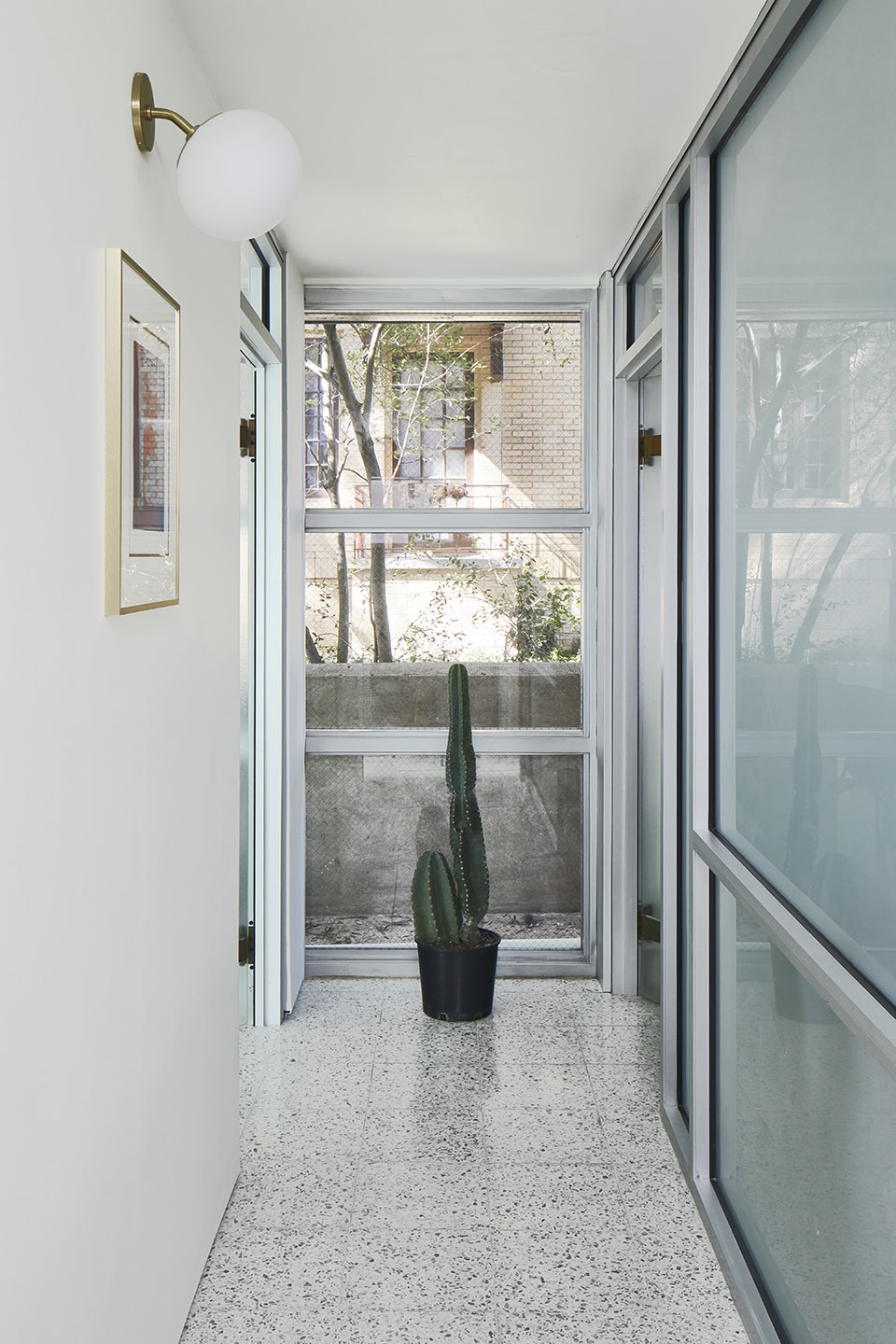
陶土磚和玻璃隔墻的對面是候診室,第二面保留的陶土磚墻呈90度圓弧,將空間圍合成一個溫馨的角落。所有原有的鋁框窗戶都位于較高的位置,柔和的陽光在兩道外墻上投射出一條條細長的光影,窗下是一面用作畫布的陶土磚墻。設計師選擇了Paul Klee抽象畫,使陶土磚墻具有雕塑感也作為上方窗戶幾何感的補充。Klee畫作可以打破現(xiàn)有色調的同時作為空間飽和色調的補充。為了布置這個造型特殊的房間,設計師采購了Milo Baughman風格的lovesea來匹配90度彎曲的空間并且保留沙發(fā)藍色天鵝絨軟墊。候診室中央有一張有趣的菠蘿形底座的圓形West Elm咖啡桌,配有黑白斑點的牛皮地毯。另一面墻邊是一張灰褐色粗花呢的丹麥沙發(fā)。座位的布局緩和了單人座椅候診室的尷尬感覺。角落的尺度、舒適的家具、精致的裝飾使候診室更像是家里的休息室而不是一個過渡空間。
▼磚墻及Paul Klee抽象畫,clay wall and abstract painting by Paul Klee
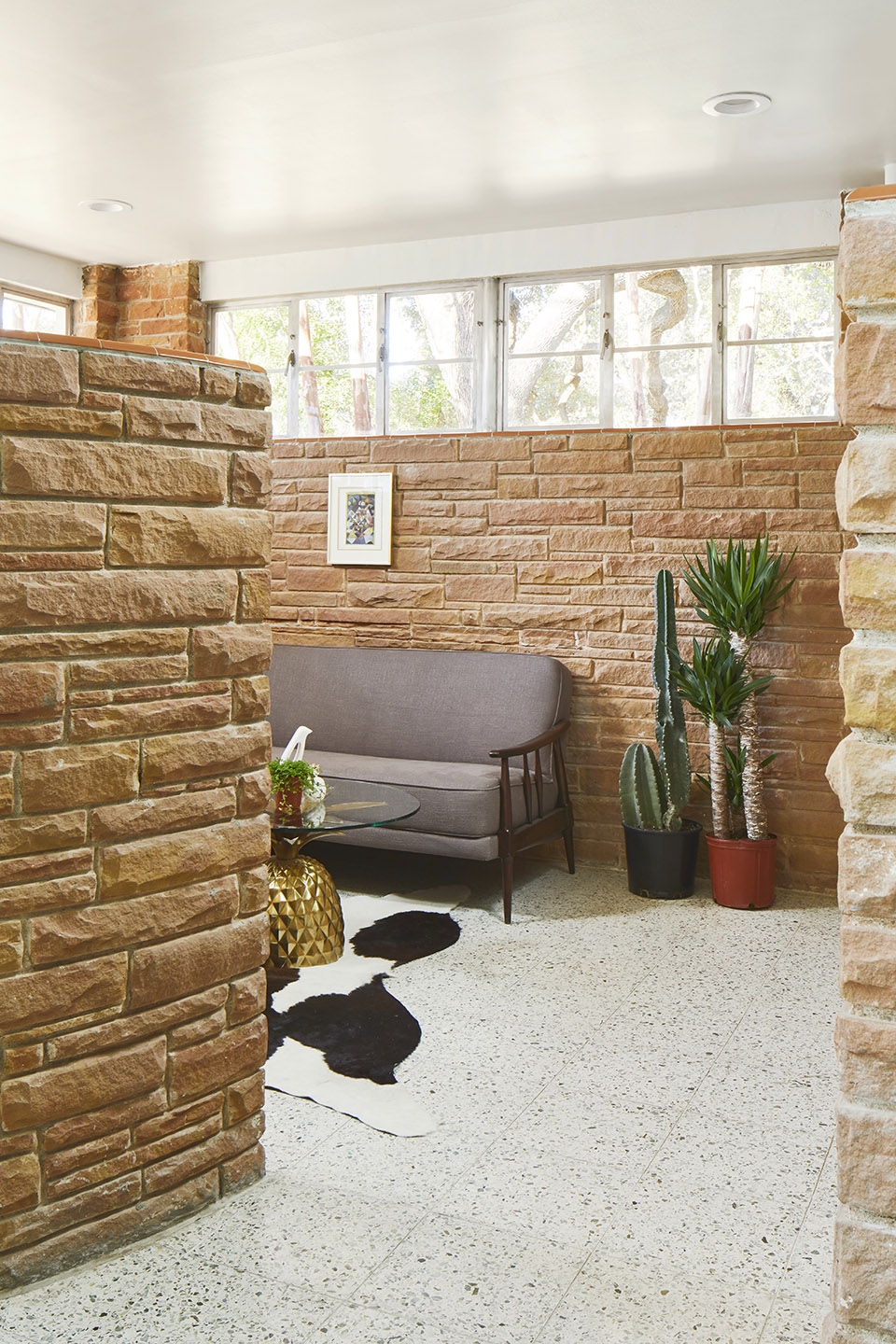
On the opposite side of the clay and glass wall became the Waiting Room – an intimate corner nook secured by the second original clay half wall which curves at a 90-degree radius. All-original aluminum windows sitting at a high sill punctured the two exterior walls with soft light in a thin strip, leaving a clay interior wall canvas below. We chose prints of abstract paintings by Paul Klee as artwork that would allow the clay walls to stand as sculptural features and complement the geometry of the windows above. Inside the frame, the Klee work could be disruptive while also featuring the saturated color palette of the space. To furnish the uniquely shaped room, we procured a Milo Baughman style loveseat that was configured at a 90-degree curved radius and upholstered in its original crushed velvet blue fabric. A black and white spotted cowhide with a playful rounded pineapple-shaped coffee table from West Elm sat at the center of the space with a tweed taupe Danish sofa on the opposite wall. The seating arrangement was conceived to alleviate the awkwardness that single-chair waiting rooms can create. The scale of the nook, its comfortable furniture and delicate trinkets make the Waiting Room feel more like a lounge at home than a transitional space.
▼第二道90度圓弧的陶土磚墻圍合成候診室溫馨的角落,the second original clay wall which curves at a 90-degree radius encloses an intimate corner nook as waiting room
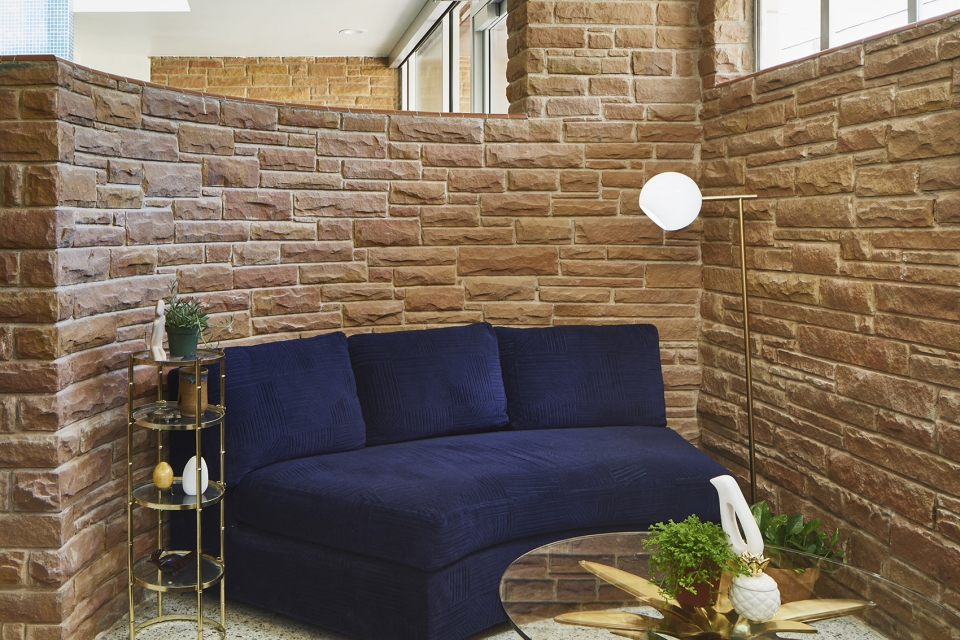
底層的每間病房內都有專門設計的木制家具,用于存儲醫(yī)生手術、清潔和銷售所用的物品。簡單的直線形的家具被涂刷為藍色,顏色與原有水磨石地面的斑點和1988年新增馬賽克墻面一樣。設計師并沒有拆除空間內原有的混凝土踢腳板,這些櫥柜被設計成漂浮在錐形拋光黃銅家具腿上的盒子。風化后的圓形銅把手帶有紅橙色調,與光滑的藍色櫥柜相得益彰,呼應了原有陶土磚墻的紋理。櫥柜的臺面使用了鈦白色的MetroQuartz,這是一種耐用的工程材料,具有脆性和功能性的工作面。圓形不銹鋼下沉式水槽鑲嵌在櫥柜內,彎曲的水龍頭和復古的十字開關與櫥柜形成了幾何對比。
▼病房內專門設計的藍色木制家具,custom designed blue wood furniture for each Patient Room
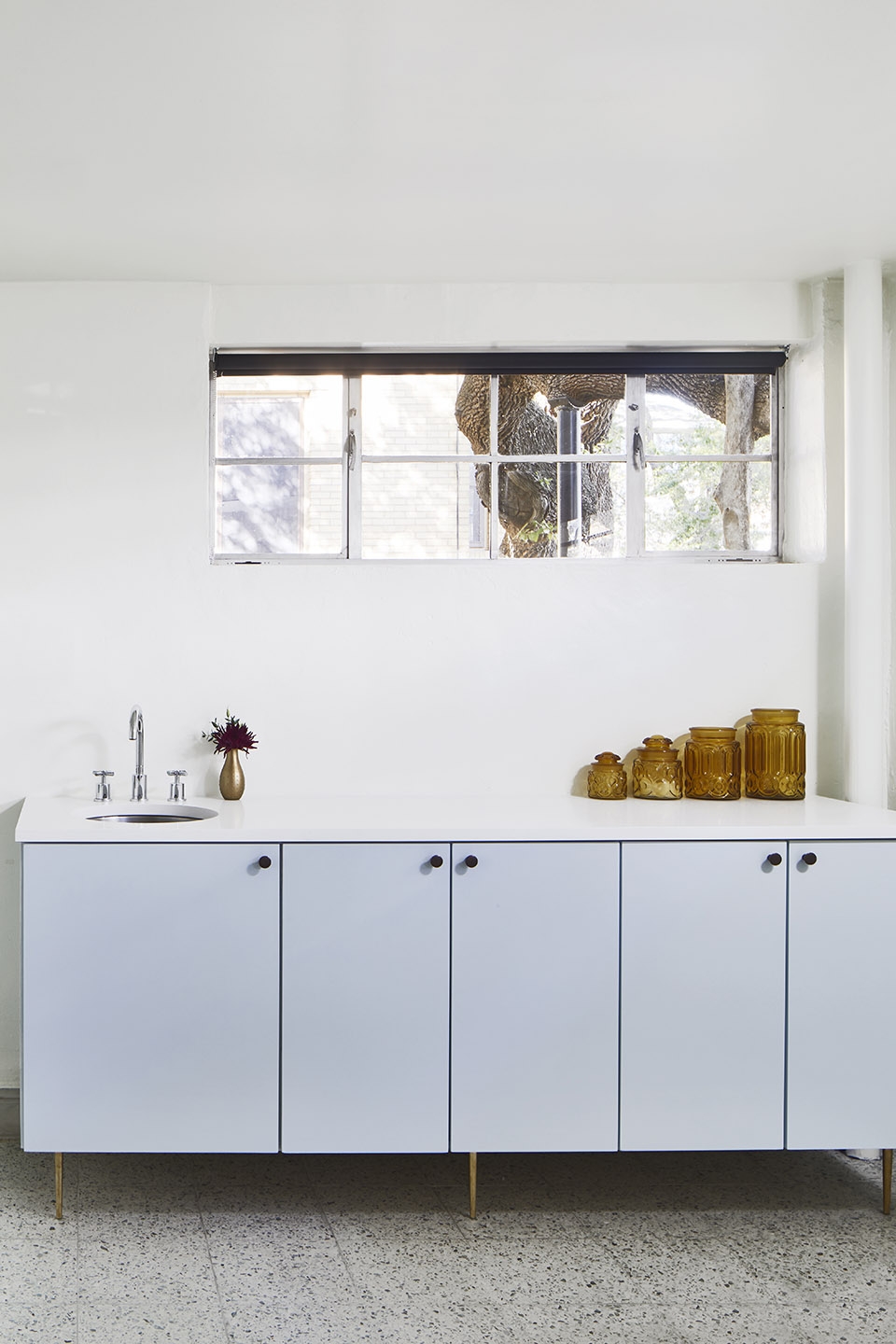
Specialized millwork was custom designed for each of the Patient Rooms on the lower level to accommodate the doctor’s storage needs for procedures, cleaning, and product sales. The cabinetry maintained a simple, rectilinear form and was painted a shade of blue drawn from flecks of aggregate in the original terrazzo flooring and the mosaic tile wall erected during the 1998 addition. Instead of demolishing the original concrete baseboards of the rooms, the cabinets were constructed as floating boxes that were reinforced and rested on conical polished brass furniture legs. Weathered copper knobs with a red-orange hue complemented the block of slick blue cabinetry and reiterated a subtle earthy texture drawing from the original clay walls. The counter tops were specified as MetroQuartz in Titanium White, a durable engineered material that yielded a crisp and functional working surface. A circular stainless steel under mount sink carved into the mass of the cabinetry and, coupled with a curvy faucet and vintage inspired cross handles, provided a contrast in geometry.
▼彎曲水龍頭和十字開關與櫥柜形成了幾何對比,curvy faucet and cross handles provide a contrast in geometry with the cabinetry
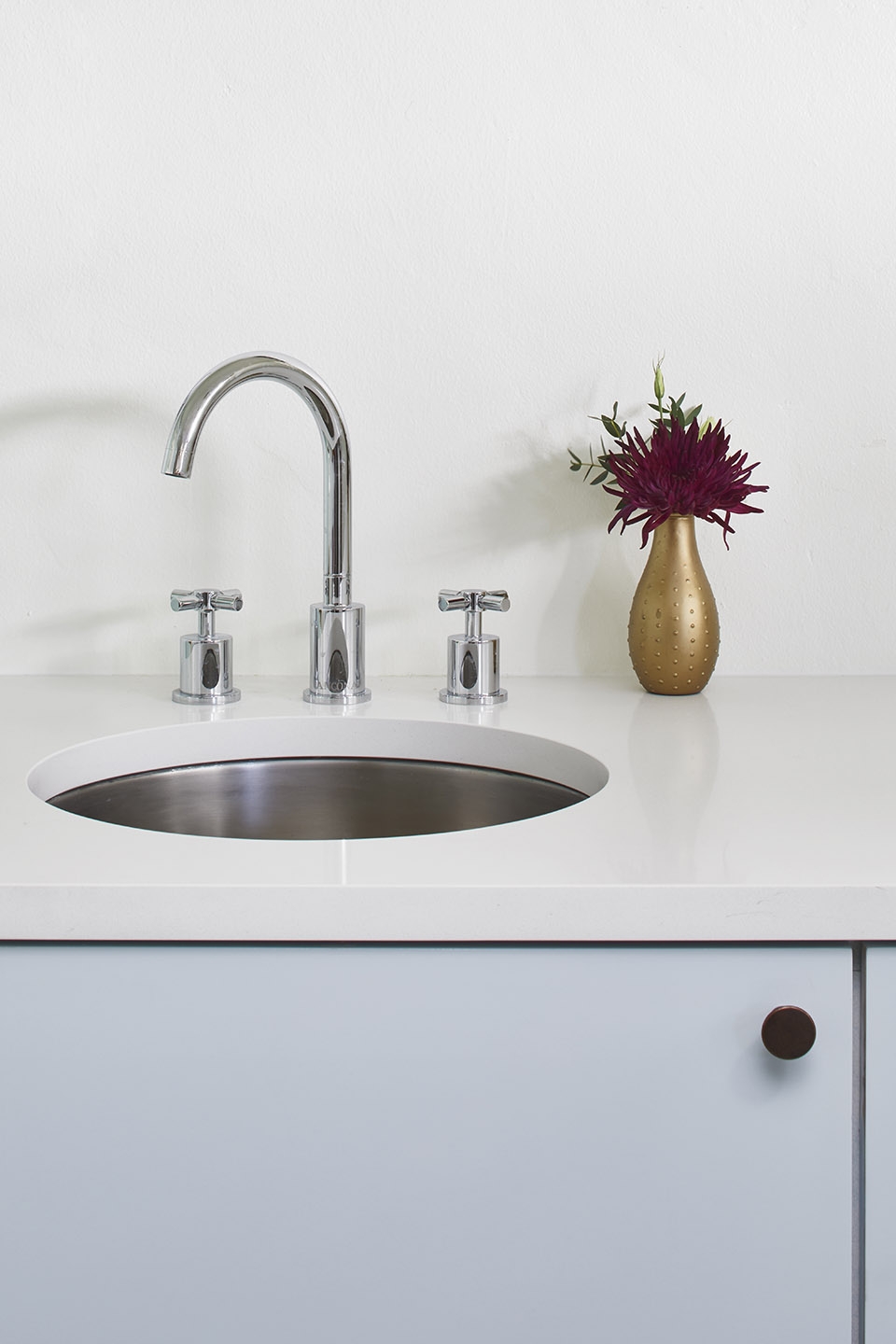
設計師在上層設計了一個大空間作為業(yè)主進行多種活動和咨詢的空間,并且更換了廚房和洗手間的設施。設計師還設計了獨特的品牌細節(jié)來紀念建筑的建成時期。活動和咨詢空間的面積寬敞,內部有從地面到天花板的玻璃窗,室外和樓梯井的天窗為室內提供了充足的光線。設計師重新布置了入口的玻璃隔斷以方面安裝與樓下病房相匹配的旋轉門和配件,進一步增強了建筑材料色調的統(tǒng)一性。空間內設置了許多座位區(qū),包括一組天鵝絨銅制椅子和一張從Uptown Modern Austin采購的復古柳條桌。外窗邊是一張搭配有郁金香的桌子和鋪有羊皮墊的銅制椅子,桌子上擺放著一個女性木制半身像。房間內部還有其它展現(xiàn)業(yè)主實踐精神和性別認同的人體圖案與裝飾物,如一個亞克力材質的面部模型,Paul Klee用柔和的線條描繪一個人面部的Head of Man系列畫作,以及一個小型抽象裸體石頭雕塑
▼二層用于活動和咨詢的空間,space for event and consultation at the upper floor
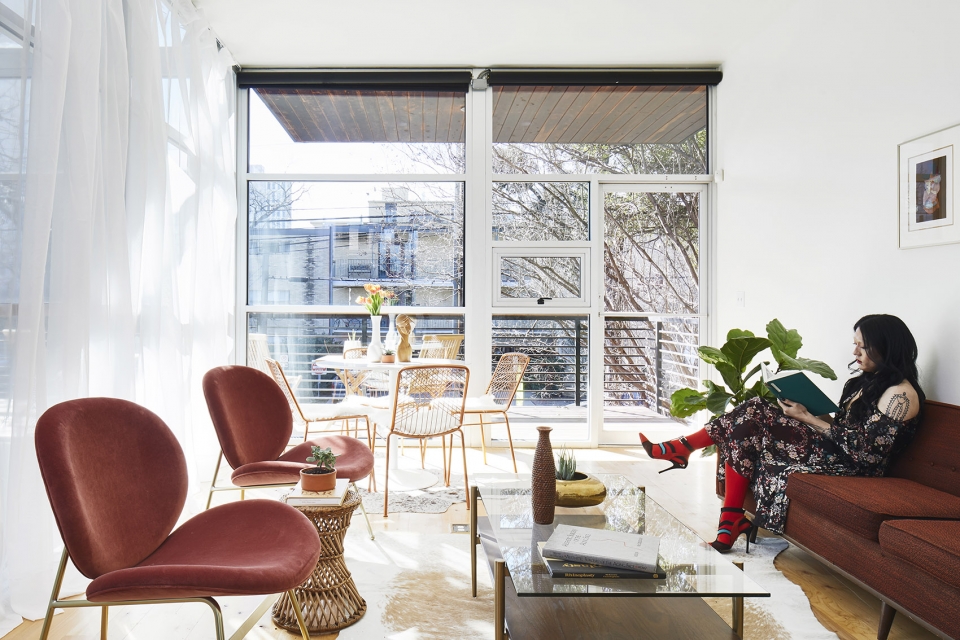
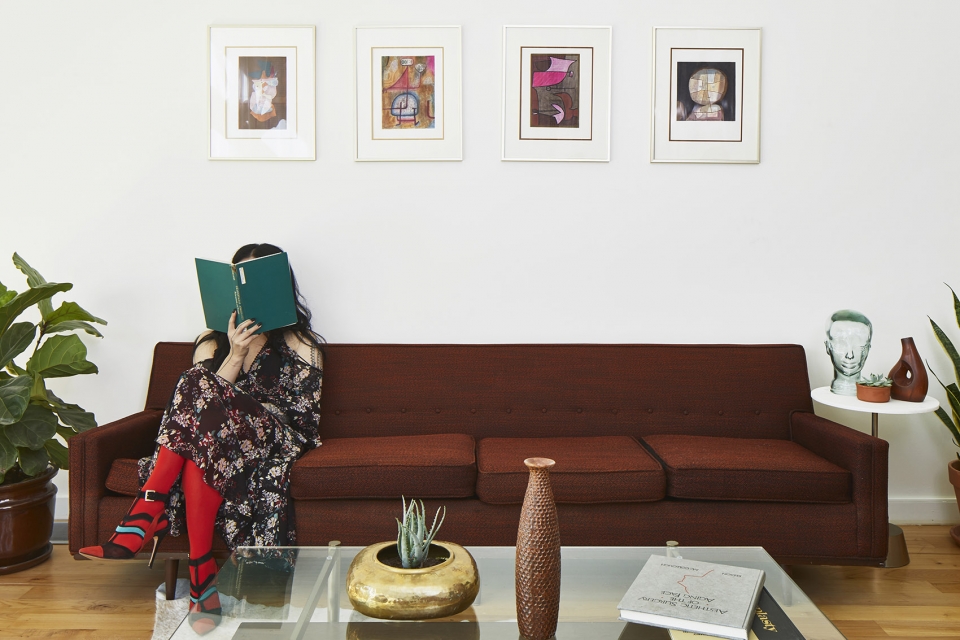
At the upper level, we configured a large room to become a flexible event and consultation space for the client, updated components of the kitchen and bathrooms, and designed special branded details that paid homage to the period of the building’s construction. The flexible event and consultation space was generous in area and had floor to ceiling storefront glass windows that offered an abundance of natural light from both the exterior and the tangential stair shaft with skylights above. We reconfigured the entry glass partition to receive a pivot door and hardware that matched the patient rooms downstairs, further instilling uniformity in the architectural material palette. Multiple seating groups were established, including a cluster of copper velvet chairs with a vintage wicker table procured locally from Uptown Modern Austin airily resting in-between. An anatomical tulip-style table was situated near the exterior windows surrounded by copper chairs and sheepskin pads with the vintage wooden bust of a female face as the table centerpiece. Other motifs and decorative objects resembling the human body adorned the room in the spirit of the client’s practice and celebration of gender identity, such as a vintage acrylic mold of a nondescript face, a Paul Klee lithograph from the Head of Man series depicting a person’s face with soft curves, and a miniature vintage stone sculpture of an undefined nude body.
▼外窗邊配有郁金香的桌子和帶羊皮墊的銅制椅子,tulip-style table was situated near the exterior windows surrounded by copper chairs and sheepskin pads
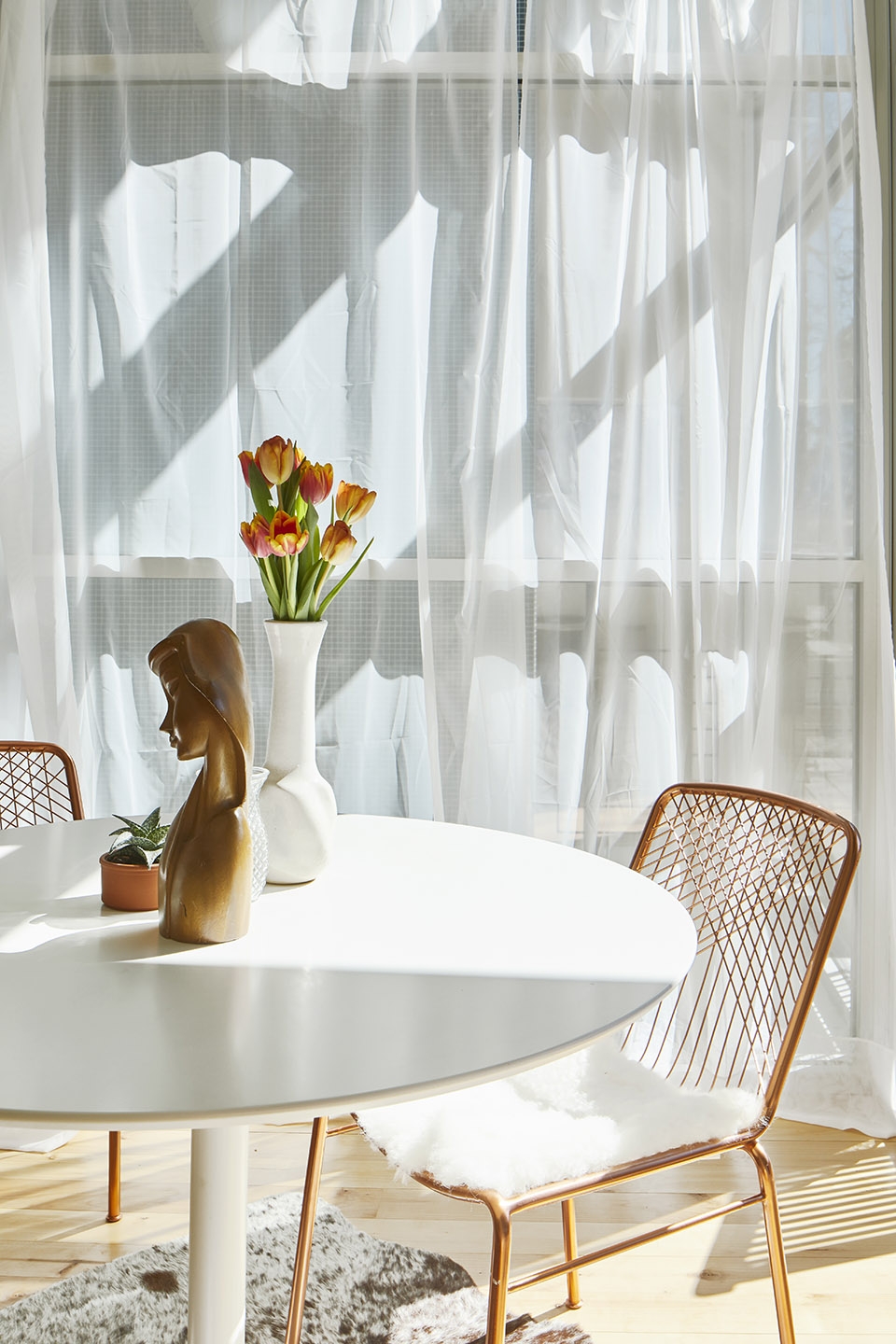
▼天鵝絨和銅構成的椅子,a cluster of copper velvet chairs

項目最后對廚房進行翻新。設計師將臺面原有的90年代末期藍色復合板材料更換為鈦白色的MetroQuartz,木制家具保持完整并安裝了一個耐火陶土磚‘Grove’制成的后擋板,暖色調的后擋板與整個建筑藍色、橙色調相融合。后擋板放射狀的鉆石圖案與能夠追溯到50年代廚房的白色Daewoo迷你冰箱、微波爐一起營造了一種奇異的世紀中期氛圍。翻新改造的主要目標是拆除和更換必要的東西,為業(yè)主塑造一個安全、舒適、愉悅的醫(yī)療環(huán)境。自50年代起一直持有和維護這棟建筑的業(yè)主和建筑擁有者對建筑改造措施進行了仔細地考量。
▼內部配有鈦白色的MetroQuartz臺面,暖色調陶土瓷磚后擋板的廚房,kitchen with Titanium White MetroQuartz counter tops and backsplash clay tile in warm hues
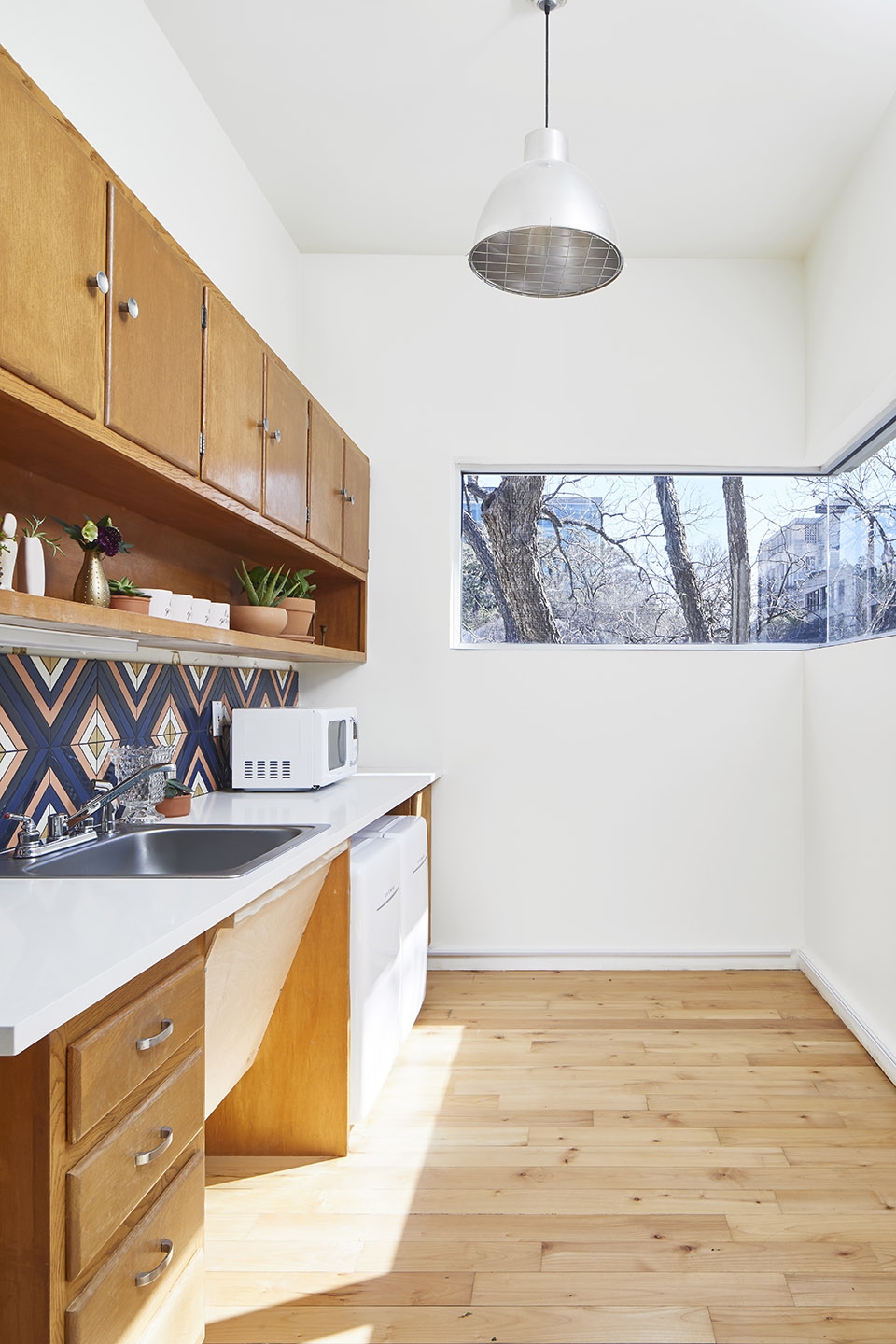
▼放射狀鉆石的后擋板圖案與Daewoo迷你冰箱塑造了中世紀氛圍,radiating diamond backsplash pattern and Daewoo mini-fridges create midcentury feature
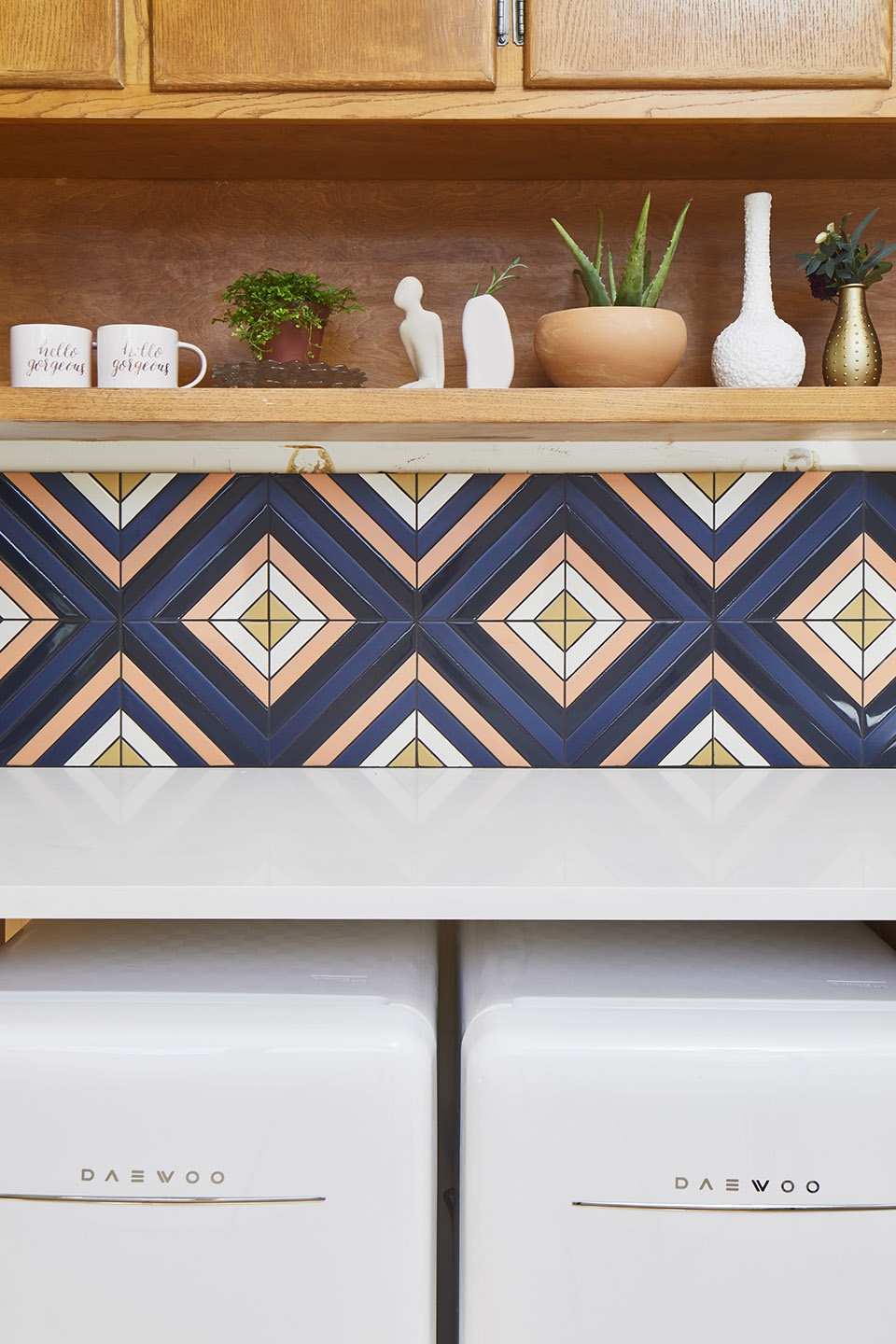
The final point of renovation occurred in the kitchen. We replaced the counter tops from their late ‘90s blue laminate material with Titanium White MetroQuartz, left the millwork intact, and installed a backsplash made by Fire Clay Tile ‘Grove’ in warm hues, which incorporated the blue and orange tones found throughout the building. The radiating diamond backsplash pattern created a whimsical midcentury vibe in conjunction with a set of white Daewoo mini-fridges and microwave oven – which harkened back to the kitchens of the ‘50s. The main goals of the renovation and restoration were to demolish and replace only what was necessary, create operational functionality for the client, and shape a safe, comfortable, and enjoyable patient environment. Architectural interventions were carefully considered with both the client and the building owners, who have owned and maintained the building since its birth in the 1950s.
▼洗手間,bathroom
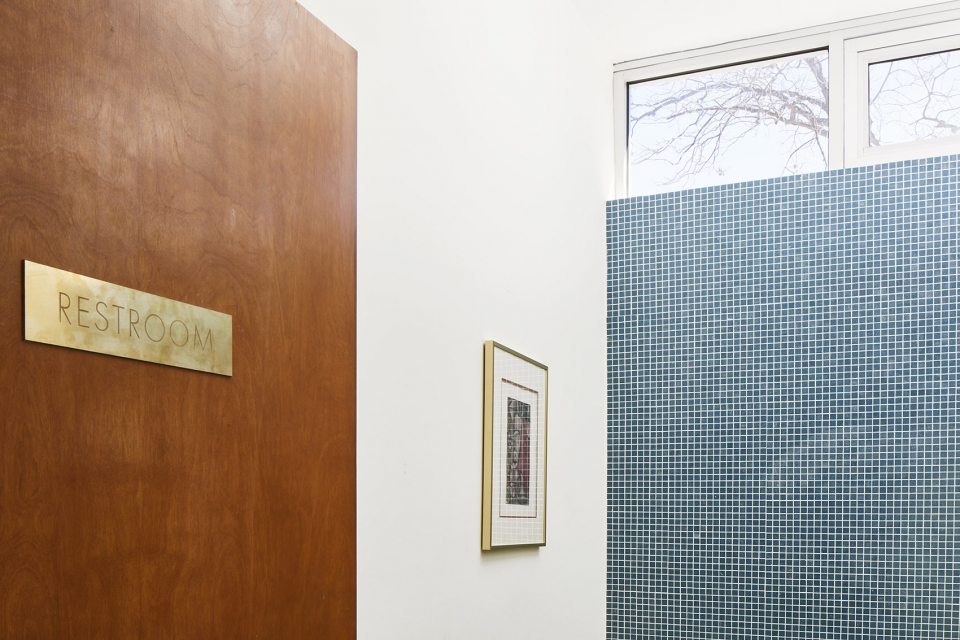
▼平面,plan
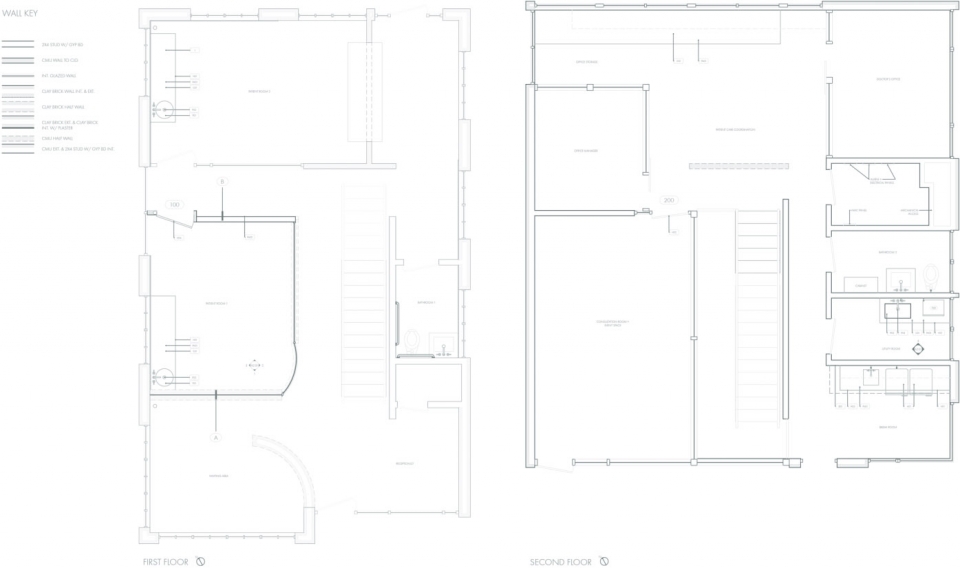
Details
Project size – 2430 ft2
Project Budget – $100000
Completion date – 2018
Building levels- 2
來源:本文轉載自谷德設計網(wǎng)(gooood)
我們重在分享,尊重原創(chuàng)。如涉及作品內容、版權和其它問題,請與本網(wǎng)聯(lián)系,我們將在第一時間刪除內容!
- 時間 2019-01-10 /
- 作者 gooood /


